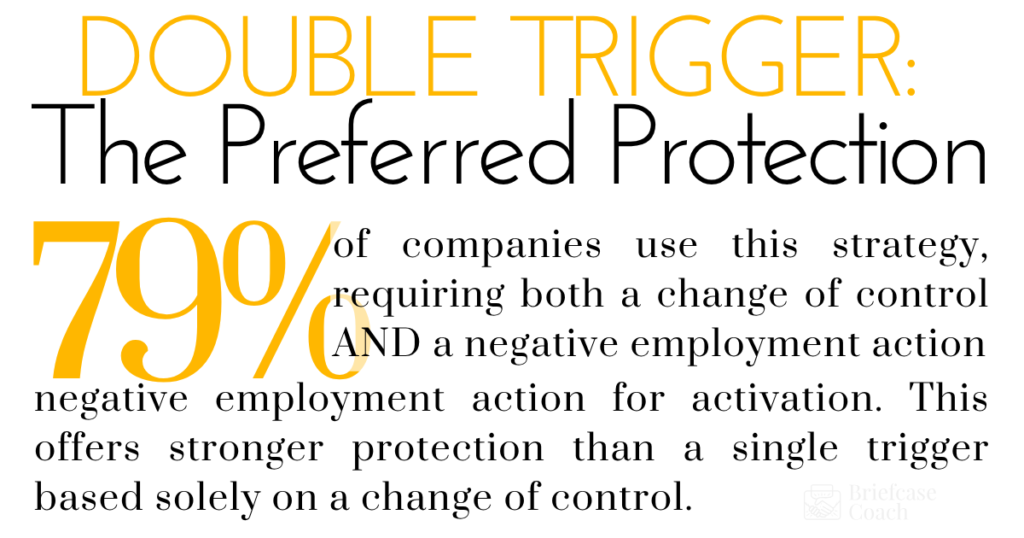Executives shoulder the significant responsibility of guiding organizations through complex challenges, making pivotal decisions with far-reaching consequences. While adept at negotiating entry terms, including salaries, benefits, and responsibilities, fewer grasp the significant importance of executive exit negotiation before commencing their roles.
Negotiating your exit early isn’t a sign of distrust but rather, it’s a hallmark of strategic leadership. It demonstrates an understanding of the complete lifecycle of your role and proactive thinking beyond the initial offer. It’s akin to insurance—you secure protection before a crisis.
Similarly, executives shouldn’t wait for instability from leadership changes, market downturns, or shifting priorities to consider their departure terms. Proactive exit planning safeguards not just your finances but also your equity, reputation, and smooth career transition, mitigating the stress of unexpected departures.
Too often, the focus on securing the offer overshadows the potential for unforeseen circumstances. However, experienced executives understand that change is a constant in business. Even the most robust plans can be disrupted by a new CEO, an acquisition, or altered investor sentiment. In such instances, your pre-negotiated exit plan becomes paramount.
The Risk-Heavy Nature of Executive Roles
Executive roles are inherently volatile. Alongside significant power, influence, and compensation comes substantial risk and uncertainty. Strategic shifts, market fluctuations, internal changes, and evolving leadership visions can precipitate swift departures beyond an executive’s control. Since they are frequently brought in during periods of significant transition (mergers, restructurings, leadership overhauls, or market expansions), the pressure to deliver is immense.
Furthermore, corporate dynamics are in constant flux. New investors, board members, or industry trends can alter a company’s trajectory, requiring leadership to adapt rapidly. For an executive, this means that even stellar performance may not guarantee long-term fit. In these scenarios, pre-negotiated exit terms can be the crucial difference between financial security and a disruptive, potentially damaging departure.
It’s easy to assume stability upon securing a role, but the inherent instability of executive positions and the prevalence of unforeseen circumstances underscore the necessity for clarity regarding exit terms before signing.
The Power of Negotiating Your Exit Terms Upfront
Leverage at Its Peak
The optimal time to negotiate favorable terms is before commitment. The hiring process is extensive, and the organization has invested considerable resources in your selection. At this stage, your leverage is highest; the company is eager to onboard you and more amenable to fair terms protecting mutual interests.
Once in the role, the dynamics shift. Emotional and professional investment complicates negotiation. You transition from an external perspective to an entrenched position within the organization’s culture and operations. The company may become less flexible regarding exit terms as stakes rise and focus shifts to performance and alignment.
Regarding upfront exit negotiation, executives must consider more than standard severance. Resilient contracts are scenario-specific, outlining outcomes for restructuring, non-performance-related layoffs, or significant strategic shifts.
Christopher Migliaccio, lawyer and the founder of Warren and Migliaccio L.L.P, states, “I’ve seen too many people assume their performance alone will protect them, only to be blindsided when company priorities change. Executives should also address healthcare continuation, reputation protection (including agreed-upon language for public communications or reference letters), and equity treatment, especially for startups or companies with long-term incentive plans.”
He advises, “Negotiate your exit with the same clarity and assertiveness you bring to your onboarding package. The best time to protect yourself is when you have the most leverage—before you sign the dotted line, not after you’re already holding the title.”
By negotiating exit terms upfront, mutual understanding is established regarding potential departures, safeguarding both financial interests and professional reputation in unforeseen circumstances. This essential safety net allows focused performance without constant worry about an abrupt, messy exit.
Avoiding the Unexpected
Change is inevitable, even in high-performing companies. Evolving market dynamics, new leadership, and shifting strategic priorities can lead to an executive’s departure, often without clear explanation. Without pre-negotiated exit terms, executives become vulnerable to external factors, potentially leaving without severance, forfeiting equity or benefits, or facing prolonged unemployment.
When negotiating an executive contract, incorporating change of control protection is crucial, especially in today’s volatile market. A robust change of control clause should guarantee salary and benefits continuation if the executive’s role or reporting structure materially changes post-acquisition. It’s vital that the trigger for this protection is based on the executive’s “reasonable determination” of material change, not the company’s discretion. Linking protections to specific metrics like budget authority or headcount can also prevent ambiguity. Securing accelerated equity vesting upon a change of control is equally important to avoid significant financial loss.
Executives should also carefully consider their exit strategy from the outset. Beyond standard severance, defining termination conditions, limiting “cause” to specific material breaches with a cure period, is essential. Ensuring continued healthcare coverage and negotiating the continuation of vesting for outstanding equity grants are also crucial. Furthermore, executives should seek extended periods for exercising vested options and consider requesting outplacement services and office space for a smoother transition. Often overlooked but critical is reputation protection—mutual non-disparagement clauses and clear messaging for departure announcements.
A pre-existing exit agreement provides a safety net, offering protection in case of unexpected or forced departure. This can include severance pay, continued benefits, or accelerated vesting of stock options or equity, mitigating the financial impact of a sudden departure and facilitating a smoother career transition. It also offers significant psychological benefits, providing peace of mind and allowing complete focus on current responsibilities without the stress of potential unforeseen circumstances.
Change of Control Clauses
A vital component of your executive exit negotiation is the change of control clause. This provision acts as a safeguard for executives when a company undergoes significant transformations such as acquisitions, mergers, or substantial restructuring of the board of directors or ownership. For this protection to be effective, the contract must clearly define what constitutes a “change of control” and precisely outline the specific protections that are activated upon such an event.
Kevin Shahnazari, founder and CEO of FinlyWealth, underscores the importance of proactive negotiation: “When negotiating a change of control, executives need to specifically request specified triggers and automatic consequences. In case of a change in ownership or when the top leadership exits, there have to be specified terms to trigger full vesting of equity, severance, and specified notice periods. Too many leaders wait for things to change before considering security, but smart executives make them non-negotiable upfront.”
A particularly effective strategy to strengthen your change of control protection is the double trigger clause. This requires two events to occur before the protective provisions are activated: first, a change of control, and second, a subsequent unfavorable employment action, such as termination, a significant demotion, or a substantial alteration of your responsibilities. Research indicates that a significant majority (79%) of companies utilize this double trigger approach, offering a more secure safeguard compared to a single trigger clause that only requires the change of control event itself.

Devin Ramos, Founder & CEO, Simplifi Real Estate emphasizes that “clarity is the most important thing for executives negotiating a change of control provision. The provision needs to define precisely what a “change of control” (acquisition, merger, board restructuring, etc.) is and which certain protections trigger.”
By proactively incorporating these well-defined provisions into your executive agreement, you establish financial protection in the face of significant and potentially disruptive company transitions, safeguarding both your financial well-being and your professional future.
What Should Be Included in an Executive Exit Agreement?
While the specifics of an executive exit agreement are context-dependent, certain fundamental elements are indispensable for ensuring fair compensation. These provisions are not merely about protecting the executive but they also contribute to a clear and predictable framework for the organization in the event of a leadership transition.
Andrew Lokenauth, Founder & CEO of The Finance Newsletter, astutely points out a common oversight: “From where I sit, the biggest mistake executives make is focusing only on standard severance terms. There’s so much more to consider.” He emphasizes that limiting the focus solely to severance overlooks the broader landscape of potential exit scenarios and the comprehensive protections that should be secured. A prime example of a frequently underestimated yet critical provision is the change of control clause.

Expanding on this, Lokenauth elaborates, “The most effective change of control clauses I’ve negotiated often include 12-24 months of salary and benefits continuation if there’s a material change in role or reporting structure following an acquisition. One critical point many overlook is that the trigger for such clauses should be based on your reasonable determination of material change, not the company’s. I learned this lesson the hard way after witnessing a client lose protection when their role was ‘restructured’ post-merger, leaving them vulnerable.”
This highlights an important takeaway: the definition of what constitutes a significant change triggering protections should, ideally, be within the executive’s purview to prevent the company from unilaterally redefining roles to circumvent these safeguards. A well-crafted agreement proactively addresses potential ambiguities and ensures the executive is shielded from unforeseen, unfavorable changes.
Beyond this critical “change of control” aspect, a comprehensive executive exit agreement should also encompass the following key elements:
Severance Compensation: This foundational element provides financial security upon termination or forced departure. It typically involves a multiple of the executive’s base salary, determined by factors such as the scope of the role, level of responsibility, and the company’s financial health. Crucially, severance terms should extend to the continuation of health benefits and retirement contributions, offering a vital safety net during a period of transition.
Equity and Vesting: For executives with equity-based compensation, clearly defined terms regarding the treatment of stock options or equity upon departure are paramount. While standard practice often involves forfeiting unvested equity, a skillfully negotiated exit clause can include provisions for accelerated vesting in instances of termination without cause or following a change of control. This ensures fair compensation for the value the executive has contributed to the organization.
Continuation of Benefits: Beyond severance pay, securing the continuation of essential benefits such as health insurance, life insurance, and retirement contributions is a critical aspect of the exit agreement. These benefits provide significant peace of mind and financial stability during a career transition.
Non-Disparagement and Reputation Protection: This is a rule that says the executive will not make negative public statements about the company after departure, and the company will refrain from doing the same regarding the executive. This helps protect everyone’s reputation.
Outplacement and Career Coaching Support: Sometimes, companies will offer to assist the departing executive in finding new employment by providing career advice, help with resume development, interview practice, and networking opportunities. This can facilitate a smoother transition to a subsequent role.
By ensuring these elements are clearly documented in the agreement before commencing the role, executives can establish a comprehensive framework that guarantees a fair and dignified departure, protecting their financial well-being and professional standing while also providing clarity for the organization.

How to Approach the Exit Negotiation
Bringing up exit terms during hiring discussions can feel uncomfortable, especially when you are excited about starting a new role. However, it is helpful to think of this as a standard and thoughtful part of any senior-level negotiation. Just as you would clarify job responsibilities, it makes sense to discuss how transitions will be handled if the company’s direction or leadership shifts.
It is important to approach the conversation with a professional and collaborative mindset. The goal is not to be adversarial but to build a fair and mutually beneficial agreement. By framing the discussion as a way to allow the executive to focus fully on their responsibilities, you show strategic thinking and an understanding of organizational complexity.
Throughout the negotiation, keep the focus on business outcomes and shared benefit. Emphasize that clear exit terms protect not only your financial well-being but also your professional reputation. This kind of planning can also help the organization by ensuring smoother transitions and reducing the risk of disruption. For example, agreeing in advance on the wording of any public announcements can help both parties maintain a positive image.
It is essential to involve experienced legal counsel. An attorney who specializes in executive compensation and employment law can help you review or draft the exit agreement. Legal support ensures the terms are fair, legally sound, and aligned with best practices for your industry and role. A good attorney will also spot potential issues, clarify ambiguous language, and protect your interests throughout the process. Having legal guidance in place demonstrates professionalism and provides peace of mind for both you and the company.
Securing Your Future from Day One
Negotiating exit terms before stepping into a new executive role is a strategic and forward-thinking move—not a signal of hesitation or doubt. It lays the groundwork for mutual respect and clarity, protecting both you and the organization. When approached thoughtfully, it ensures that any future transition, whether planned or unexpected, can unfold in a smooth, professional, and dignified manner.
In the unpredictable world of corporate leadership, those who proactively plan their exits show more than caution—they show vision. Executives who take the time to secure well-defined terms are demonstrating business acumen, confidence, and a commitment to leading with clarity. This level of foresight allows them to navigate even the most complex situations with stability and purpose.
Ultimately, negotiating your exit before day one is not just about covering worst-case scenarios. It is about setting yourself up for long-term success and creating a foundation where you can lead boldly, focus fully, and build a career that is not only impactful but sustainable.

